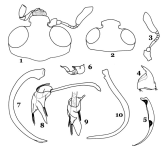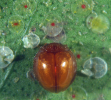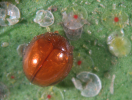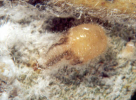Scientific name
Serangium parcesetosum Sicard (=Catana parcesetosa (Sicard))
Systematic position
Coleoptera: Coccinellidae: Sticholotidinae: Serangiini
Diagnosis
Length 2.04-2.16 mm, width 1.62-1.80 mm. Form hemispherical, only slightly longer than
broad, strongly convex, dorsal side shiny with sparse, erect, thin silvery white hairs on pronotum, anterior and lateral margins of elytra. Colouration uniform reddish brown or yellowish brown on both sides. Compound eyes large, coarsely faceted, interocular distance at its narrowest slightly less than
twice the eye width (Fig. 1). A row of dark reddish brown spots (not amounting to true punctations) present on either side of suture. Male genitalia (Figs. 7, 8) asymmetrical, both parameres triangular. Larva pale greyish with a greenish tinge, spindle-shaped and strongly narrowed towards apex in the posterior half. Very similar to S. montazerii Fursch, commonly distributed in northern / northwestern India, in general appearance, and can be differentiated mainly by larger and less broadly separated eyes (interocular distance slightly more than twice the eye width (Fig. 2) in S. montazerii) and male genitalia (Fig. 9, 10). Further, S. montazerii is paler and elytral punctations are finer and more prominent than those of S. parcesetosum.  Figs. 1-10. Diagnostic characters of S. parcesetosum and S. montazerii: 1. Head, S. parcesetosum; 2. Head, S. montazerii; 3. Antenna; 4. Mandible; 5. Elytral epipleuron; 6. Female spermatheca; 7, 9. Male genitalia, S. montazerii; 8, 10. Male genitalia, S. parcesetosum. Figs. 1-10. Diagnostic characters of S. parcesetosum and S. montazerii: 1. Head, S. parcesetosum; 2. Head, S. montazerii; 3. Antenna; 4. Mandible; 5. Elytral epipleuron; 6. Female spermatheca; 7, 9. Male genitalia, S. montazerii; 8, 10. Male genitalia, S. parcesetosum.Images

 Adult feeding on indeterminate whitefly Adult feeding on indeterminate whitefly

 Adult feeding on spiralling whitefly, Aleurodicus dispersus (Russell) Adult feeding on spiralling whitefly, Aleurodicus dispersus (Russell)
 Adult in dorsal view Adult in dorsal view

 Larva feeding on Aleurocanthus arecae on coconut Larva feeding on Aleurocanthus arecae on coconut
 Pupa in a spiralling whitefly colony Pupa in a spiralling whitefly colony
Distribution
India: Fairly common in central and peninsular region, especially southern states
(Bihar; Delhi; Gujarat; Karnataka; Kerala; Maharashtra; Tamil Nadu; Uttar Pradesh). Introduced into the USA and Turkey. Its close relative, S. montazerii is apparently confined to north and northwestern regions of India and not recorded in peninsular India.
Prey / Associated habitat
HEMIPTERA: Aleyrodidae: Aleurocanthus arecae David, Aleurocanthus woglumi
Ashby, Aleurocanthus sp., Aleurodicus dispersus Russell, Aleurolobus barodensis (Maskell), Bemisia tabaci (Gennadius), and Trialeurodes ricini (Misra). Coccoidea:
Coccus hesperidum Linnaeus, Hsuia sp., Ferrisia virgata (Cockerell). Collected in association with whiteflies infesting cotton, castor, coconut, guava, sunnhemp, etc. Introduced into the USA for controlling the silverleaf whitefly, Bemisia argentifolii Bellows & Perring (Legaspi et al., 1996) and Turkey.
Seasonal occurrence
Collected during March-June and August-September in different parts of peninsular India.
Note
References to Cryptognatha flavescens Motschulsky from this region in old literature (Hussain & Khan, 1945; Pruthi & Mani, 1945) involve either S. parcesetosum or S. montazerii. Timofeyeva & Hoang (1978) provided an account of the biology and the description of larva and pupa of S. montazerii as Serangium parcesetosum.
References
- Booth, R.G. & Polaszek, A., 1996. The identities of ladybird beetle predators used for whitefly control, with notes on some whitefly parasitoids, in Europe. In Proceedings of the Brighton Crop Protection Conference-Pests & Diseases, 1996, pp. 69-74 (male genitalia illustrations,
description).
- Lefroy, H.M. 1909. Indian insect life. Agricultural Research Institute, Pusa, India (illustrations of life stages, as Clanis soror).
- Legaspi, J.C., Legaspi, B.C. Jr., Meagher, R. Jr. & Ciomperlik, M. 1996. Evaluation of Serangium parcesetosum (Coccinellidae) as a biological control agent of the silverleaf whitefly. Environmental Entomology 25(6): 1421-1427.
- Poorani, J. 1999. A new species of Serangium Blackburn (Coleoptera: Coccinellidae), with a
key to species from India. Journal of Biological Control, 12 (1998): 55-61 (male genitalia illustrations).
|